The Scripture Heritage fro the Lesnovo Monastery in Macedonia
Ilija Velev (University of Skopje)
Historical view on the Lesnovo monastery
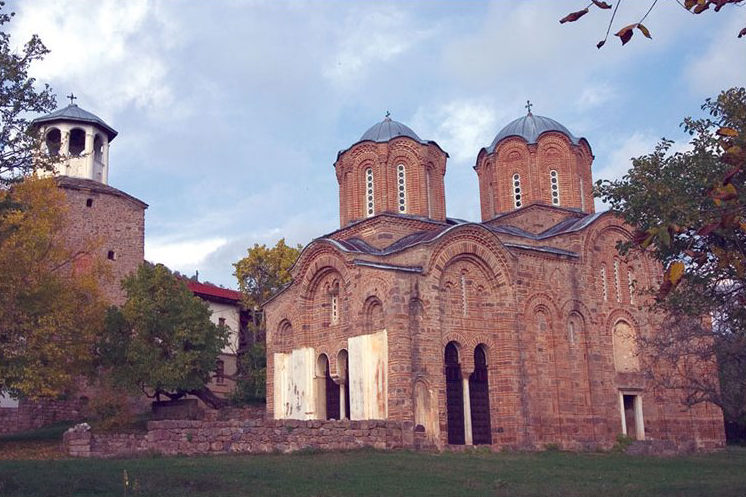
The monastery of Lesnovo is located at the beginning of the village Lesnovo, near Zletovo and Probistip – in the North part of Macedonia. Its temple is dedicated to the archangels Michael and Gabriel, but also to the local Saint Gavriil Lesnovski. It is an important spiritual i literacy center in Macedonia preserved the tradition from ten century. As a big spiritual center it hosted many events from the church history in Macedonia, at the same time distinguish oneself by the monastic life, serving to God, the church-ruling organization, lecture notes activity and the cultural issues in general.
Exploring through the historical documents we can not find the facts about precise determination for the date of the monastery building. In legends and in literacy sources its existing is related to the time of St Gavriil Lesnovski activities. According to the saved parts of the short and the largest version of the Gavriil’s script there are two different views for the establishment of the monastery. In the short version which is an older one, is announced that the monastery was grounded by Gavriil himself, and by that he was its first founder. The other, longer version of the script claims that the monastery already existed when Gavriil became monk and got blessing from the abbot to leave on hermitage in Zletovos Mountains. We believe that the older version is more relevant, because the one who was created later had influence from the legends and from many historical and church-ruling interests. According to that, we claim that The Lesnovo monastery was build at the time when Gavriil became monk (first half of the 11th century) or at a certain time after his death through the process of the moving of his bones (second half of the same century). Thirty years after his death his bones were discovered and the monastery was build or upgraded in his honor. The church solemnest have kept the cult of the saint, because the sympathy and the popularity toward him at the same time were protection to the monastery cult. In its early existence the monastery was independent and not functioning under other monastery center. But soon it became big spiritual center with many monks, and till 14th century was flexible for every spiritual or political condition that was created with the invaders of Macedonia. In the saved script from 1330 in Lesnovo prolog written by Stanislav Lesnovski (Belgrade, SANU No.53) is mention the monastery dedicated to St.Archangels and was assumed that there was the grave of the Saint Gavriil. There was monkshood with abbot Teodosij as a leader and according to his request Stanislav has rewritten the Prolog with the shorter script for St Gavriil Lesnovski. That is taken as evidence that in 1330 the monastery of Lesnovo existed in the architecture model as its first-build construction and was important spiritual and literary center.
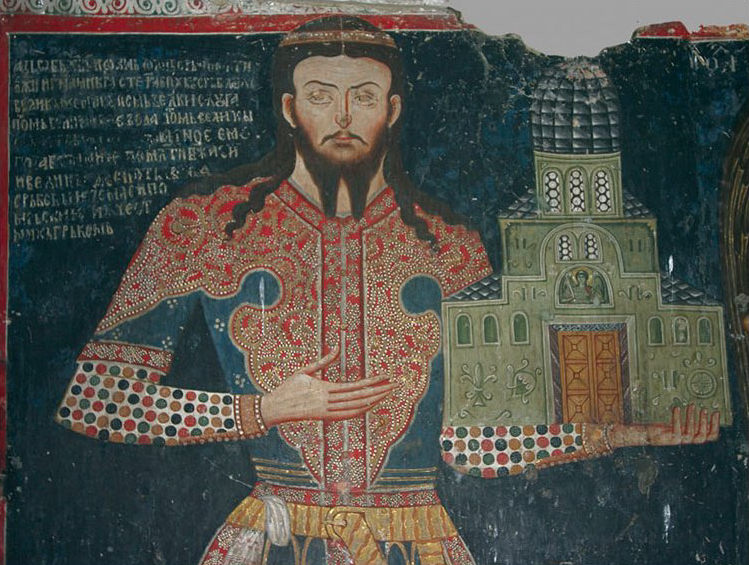
At the end of the thirty’s of 14th century the monastery temple got devastated, and according to Efrem Karanov it was ruined shortly after that. Dushan’s warrior Joan Oliver has rebuilt the Lesnovo’s monastery and now he was its founder. This act was materialized with a script that was placed above the door on the church. This script, together with its continuation that was transferred on the south portal, is representing the short version of the first charter of Lesnovo from the duke Oliver from 1341. According to this charter the monastery of Lesnovo got its own authority with big property which was the main reason why it became a big spiritual and literacy center. Its economic wealth attracted big number of monastic brotherhood that developed rich spiritual and literary life. In 1342 the monastery was connected directly with Mt. Athos. At that time Joan Oliver has given the monastery under jurisdiction of Hilendar monastery. The highest church-administrative promotion of the Lesnovo Monastery was on the familiar state Gathering in Skopje 1347, organized by the serbian invader tsar Stefan Dušan. In that time the Lesnovo monastery has grown from abbess to place of the newly formed Zletovo episcopate that had to continue the traditional function of the neglected Morzovian episcopate, whose roots are found in Bregalnica’s episcopate. This time the Lesnovo monastery was released from the Hilendar property, and tsar Dušan has taken the obligation to make up for the Hilendar property, such as on other places too. He gave new charter to the Lesnovo monastery and according to that, the property of the newly formed episcopate has joined the old and neglected territory of the former Morozvidian episcopate. The founder Joan Oliver got the privilege to take part in the election of the Zletovos bishop and the privilege to decide who will be the abbot of the monastery. As a new episcopate center in 1349 Lesnovo monastery had enlargement of its basic construction and new wall-painting were made.
After Tsar Stefan Dušan’s death in 1355, Joan Oliver’s inheritors were unable to protect the monastery. The new-created political and war circumstances had their influence Lesnovo monastery to go back to Hilendars jurisdiction. The Hilendars monastery has noticed that and its abbot Sava officially has asked for the Lesnovos monastery back as its own metoh. According to the law regulations in the previous charter of Stefan Dušan, the new monarch of the Kratovos area Konstantin Dejanovič has published new charter on 15th of August 1381 and with that the Lesnovo monastery went back to Hilandar’s competence. Probably that charter was an official act that repealed the Zletovo’s episcopate. Its euphrasy had come under the Velbužd episcopate.
During the disgraced attacks of the Turkish invaders in Macedonia in the last quarter of 14th century the Lesnovo monastery was spare because the roads on that way were trackless, so the Turkish have settled there little later. Besides that, that area was rich with mind and that was a reason not to be exposed on mass vandalism. Still, in 15th century the monastery property was rubbed and the monks were expelled. In the 20s of the same century his scriptorium was active when Drajko from Bdin has rewritten the script in Lesnovo. Joan was an abbot at the end of the 80s. Probably at the end of the century the monastery became neglected, which was a rescue call for the local donors and founders. Duke Stefan Balentic, the brothers Nikola and Georgi Pepic, Nikola Boicic and many more were standing out. New additions were made, such as repairs, covers of the monastery complex and the temple. Also new property were added to the monastery, more book were added to the library est. Important role for the spiritual existence of the monastery had the abbot Dionosij, but also and the monks Neofit, Pavle, and Spiridon. In 17 century the monastery was ruled by the abbot Maksim, the monks Kiril, Gavriil and Nektarij. With their activity and with the help of some Christian donors more reconstructions were made. The war consequences from the Austro-Hungarian battle in 1683 and from the Karpos rebel conduced to new disintegration of the Lesnovos monastery. Many of its monks immigrated and the monastery was robed. At the end of the 17th and beginning of the 18th century the monastery got better because of the activity of the abbot Isaija and the monk Teodosij. Magnificent activity for the spiritual rehabilitee was showed also by the monks Nektarij and Teodosij.
Big number of the recorded scripts testified that in 18th century the monastery has become one of the most famous spiritual centers in Macedonia that attracted many devotees from different places. At the end of the previous century Makarij and Eftimij has joined the monkshood, and during the 17th century priest Kiprijan became a monk and took the monks name Kalistrij, priest Gore with the monks name Gerasim became abbot of the Karpinskian monastery, and priest Kiprijan became monk in the Rilian monastery. Monk Gavriil, Teodosij, Stanko, Stole Cikov and others have left the Lesnovo monastery. The list of the monastery devotees and visitors from that time is very big. We will mention only few: Jakim from Rila, monk Sofronij, Mojsej and Erotej from the Rilans monastery priest Ivan, monk Joanikij, priest Leontij, the monk from Studenicani Stefan, Sofronij from Pek, monk Lazar from Kovačevci and many more. It’s interesting to mention that patriarch Arsenij has visited the monastery twice and left his own memoirs in 16th century (Zadreb, HAZU IIIc 17, f.335v). Lesnovo’s monastery condition became bad again around 18th century and the monastery was neglected. The monk Teodosij Dečanski has found the monastery in that condition, so he build it up with the help of good willing Christians building new quarters. He became new abbot and brought back the monk’s life and also exalted the spiritual and literary activity. The famous group of engravers of Petre Filipovič Garkata (with Makarie Frčkovski and Dimităr Stanišev) has made the wooden part of the church.
Through whole 19th century the monastery was developing its spiritual and literary activity with different intensity, depending on the economic and military conditions. It was ruled by many abbots and we will mention some like: Arsenij, Natanail, Dionisij, Kiril, Hadži-Pavel from Jerusalem, monk Kozma from the village Krčovo-Demir Hisar and others. This monastery was place for personal comfort to many priests who were coming to see Gavriil Lesnovski. We will mention: monk Teodosij Dečanec, Artemij Kjustendilec, priest Stojan Kjustendilec, monk Dionisij and many more. Many places considered as saint were building around the monastery that was now considered as formed spiritual center. In the historical reviews of many researchers the monastery and its surrounding were called “small Saint Mountain” (drawing a parallel with Mt. Athos). This was registered in the content of the saved historical-literary text titled like: Producing from the Lesnovo’s monastery, written by monk from Lesnovo. We meet with this Producing from the Lesnovo’s monastery in more transcripts from XIX century, mostly formed by the text for St. Gavriil Lesnovski. Our researches move the origins of the original text in the 16th century, around when the catch text was created too. This text was transcript till 19th century without its content being changed. All of the mentioned temples existed then too but as rubbles. Its assumed that most of them were ruined with the war at the second half of 17th century, when the Lesnovo’s monastery was ruined too.
Until today’s living when we celebrate the 2000 from Christ’s birth, this monastery has kept its rich spiritual and literary tradition. At times when the monk’s life wasn’t active or going down it was ruled by the village’s priests. In the 80s of the 20 century the abbot Gavriil (Mihajlo Parnadžiev) was active in the monastery. This educated man who was also an artist and writer was strictly determined to the monk’s way of living and after his death in 1990 was buried in the monastery yard. After his death, priest Gavriil from Vladimirovo was taking care of the monastery. Even now (at the beginning of the 21st century) the monastery of Lesnovo stands for one of the biggest and most important centers of the Macedonian Orthodox Church. The former metropolian, now archbishopric of Odid-Macedonian Mr. Stefan, as his inheritor its High clergy Mr. Agatangel, and the current metropolitan its High clergy Mr. Ilarion (till recently abbot of the monastery) treat the Lesnoco’s monastery with big respect and high submissively. Its very important that the monks way of life is back in the monastery and the responsibility for that goes to now’s bishop Ilarion and the brothers monks Antonij and Damaskin.
Literature: Стеван Симић, Лесновски манастир Св. оца Гаврила, Београд 1913; Гордана Томовић, Повеља манастира леснова, Историјски часопис, књ. XXIV, 1977, 83-122; Коста Балабанов, Антоние Николовски и Димитар Ќорнаков, Споменици на културата на Македонија, Скопје 1980, 112-117; Димитар Ќорнаков, Македонски манастири, Скопје 1995, 159-166 и Скопје 2005, 103-109; Александар Апостолов, Манастир „Св. Гаврил Лесновски“, Кочани 1997; Илија Велев, Лесновскиот книжевен центар, Скопје 1997; Ѓорги Поп-Атанасов, Илија Велев и Маја Јакимовска-Тошиќ, Скрипторски центри во средновековна Македонија, Скопје 1997, 145-170; Смиљка Габелић, Манастир Лесново. Историја и сликарство, Београд 1999; Илија Велев, Лесновскиот манастир – значаен духовен центар во северниот дел на Македонија, Годишник на Софийския ун-т Св. Климент Охридски. Център за славяно-византийски проучвания “Иван Дуйчев”, т. 93, София, 2003, 113–120; Вера Стојчевска-Антиќ, Локални хагиографии во Македонија, 2 изд., Скопје 2003, 50–55 и 156–177.
Saint Father Gavriil Lesnovski
Father Gavriil Lesnovski was born in the village Osice, between Kriva Palanka and Kratovo at the end of 10th and beginning of 11th century. He got his cult as ascetic and together with the ascetic Joan Rilski, Joakim Osogovski and Prohor Pcinjski is part of the “honored four god chosen brotherhood” – founders of south Slovenian and Macedonian monkshood. Generally, the facts about father Gavriil have legendary character and we can se them in his scripts and catch legends. He achieved his deed in the first half of 11th century. He died at the end of first half of 11th century. He was active in Zletovo’s Mountain, being ascetic in four ascetic-caves: first on south, the second one was in the place Gradishte where he painted the Virgin Mary, the third was dedicated to saint Ilija and the fourth was on Oblov Vrv. The Saint cult about him has grown after his death, but during his living he was worshipped for his miracle-working and healing power. His cult is connected with the many centuries’ history of the monastery of Lesnovo, dedicated to the St. Archangel Michael and Gabriel. Even in his scripts we can find information that he built the monastery, or that he became monk there and from there he left in ascetic way of living. Probably the monastery temple was built after his death and there were exposed his relics. The saint cult of this ascetic was spread and developed by forms of religious-spiritual, literacy, musical, artistic and catch tradition. His ascetic deed gained popularity and had an impact in that area for developing the monkshood. This example was followed by many monks from Lesnovo’s and others monasteries, from which some left in ascetic way of living and the others, looked up to the religious discipline. Through the middle-century three scripts and church services were created for him: the first one in the second half of 11th century, the second one in 13th century and the third in the second half of 16th century or possibly latest by 17th century. The first script about him is not saved. The transcripts from the second variant of the script are filed in the Stanislavovian’s prolog from 1330 (Belgrade, SANU No.53), Lesnovo’s prolog from the time between 1330 and 1340 (Belgrade, NL – New collection Rs 705) and in the Third Lesnovian prolog from 1340 (Belgrade, NB – Old collection No.27). Transcripts from his church service are filed in now not saved manuscripts: Oliver’s menaion from 1342 (Belgrade, NL – Old collection No.62) and in Stanislavian’s menaion from 14th century (Belgrade, NL – Old collection No.15). The third catch forms of the script and the church service for the father Gavriil is recorded in more saved and not saved transcripts, mostly coming from 19th century. Above all, the transcripts from Joan Hrstev from 1868 (Sofia, NB No.988) and transcripts from Dimitrie Hristov-Kratovec from 1868 (Sofia, CIAI No.1188) were taken under consideration. The cult of Father Gavriil has taken its place in art tradition too through painting his portraits on the icons, manuscripts and other church inventory. Mostly, his portraits were placed in the monastery of Lesnovo and others monasteries where the cult of group south-Slovenian monkshood was represented. There are many legends about him that existing till today.
Literature: В. Ламанский, О некоторих славянских рукописях в Белграде, Загребе и Вене, Записки Имп. академии наук, 1, СПб.1864, 120–123; Првош Сланкаменац, Легенде о јужнословенским анахоретима, Гласник српског ученог друштва, књ.1, Скопље 1925, 215-235; Цв. Грозданов, Портрети на светителите од Македонија од IX-XVIII век, Скопје 1983, 159-180; Илија Велев, Свети Гаврил Лесновски во книжевната традиција, Скопје 1996; Илија Велев, Лесновскиот книжевен центар, Скопје 1997; Вера Стојчевска-Антиќ, Локални хагиографии во Македонија, 2 изд., Скопје 2003, 50-55, 156-177.
The mural, xylography and inscriptions from the monastery of Lesnovo
The murals from Lesnovo’s monastery are one of the most magnificent art achievements from 14th century, so it’s under a lot of analyses from the history of art researches. The whole inside of the temple is full with murals, which were painted in two stages: first in the time between 1341 and 1346, and the second in 1347/48 and 1349. The painting was made by more icon-painters and during the conservation of the monastery in 1962 Kosta Balabanov has discovered most of their names: Sevasto, Marko, Mihail and on the fourth person the name is not defined. All the icon-painters have left their signature on small circle fields. Still, the researches didn’t make it to define precisely the particular authority on each icon-painter. But they think that probably the anonymous icon-painter was the main one who made the mural. In 1349 there were paintings from the icon-painter Mihajlo from Kostur. Among the mural ensemble, the painted portraits of the founder despot Jovan Oliver and his wife Marija, the portraits of the Serbian conqueror of Macedonia Tsar Stefan Dušan and Queen Elena, of archangel Michael and of the monk Gavriil (also and the monks Joakim Osogovski and Prohor Pčinski) were standing out. There were many other portraits of other Christian saints, and of many scenes from the Bible and Christian holidays. Its mark left the mural made at the time between 1811 and 1841 made by them very famous group of Petre Filipovič-Garkata (the masters of the wall-paintings on Bigorski monastery, on church St. Spas in Skopje and other temples).
Lesnovo’s Literary Center
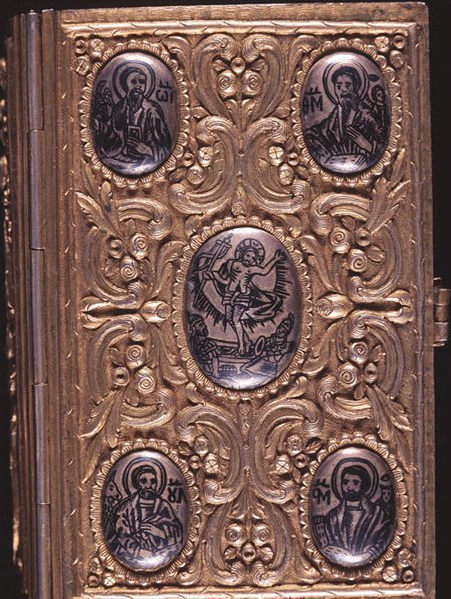
Lesnovo’s literary center has played significant role in middle century for developing the literary processes in Macedonia and at the same time contributed for building Macedonian literary relations with Byzantine, Serbian, Bulgarian, Russian and other Middle Ages literatures. First literary appears in this century are marked since the second half of 11th century, at time when the monastery dedicated to the Saint archangels Michail and Gavriil was founded and when the first text variants of the script and the church service for father Gavriil were put together. The monastery got its full affirmation as literary center in 14th century when the monastery was renovated and when it became place of the newly-formed episcopate. Zletovo’s episcopate was like an extension of the Morozvidian episcopate. The literary heritage from this spiritual center is very big and various. The activist from Lesnovo Stanislav who was writing and organizing the literary activity at the first half of 14th century was standing out. The first manuscript attributed to him was a Prolog written in 1330, at the time before the temple is renewed in 1341. Right after that, in 1342 he copied a Menaion by a request of the local ruler Joan Oliver. From his hand two more Prologs materialized with the same prototype known as Second and Third Lesnovo’s Prolog. In the three Prologs a Vita of St. Gavriil Lesnovski is presented. As his own manuscripts are identified Menaion for December-February and Prolog for December-November. On the first prolog from 1330 his student Partenij was signed too, and in that time in Lesnovo scribers Tahota, Kalinik were active too. After that, the process of literary developing has come, when manuscripts from the 19th century were transcript. In 1428 literary Drajko came in the Lesnovo’s scriptorium. In 17th century the literary activity was supported by monks Kalinik and Kinstantin. The monastery of Lesnovo has taken active part in the education-renaissance movements during the 19th century. Till then, the many centuries transcript tradition was still functioning in the Lesnovo’s scriptorium even though the monastery library was rich with printed books. We will mention only the manuscripts of priest Nikola, teacher Hristo, priest Joan Hrstev, monk Makarij, teacher Dimitrie Hristov Kratovec and others. It’s assumed that in Lesnovo’s monastery Joakim Krčovski has developed literary and spiritually. Betwen 1867 and 1870 in Lesnovo’s monastery as its abbot stayed Pavel Bozigrobski from the village Konikovo. In Lesnovo’s monastery library were a lot of manuscript books, and among them there were manuscripts of Ohufrie Osogovski (15th–16th century), Filimon (16th century), Matej Slepčenski (16th century), Kiril Pejčinovič and others.
Manuscript’s heritage
The list of saved manuscripts from the monastery of Lesnovo is pretty big, but not even one is saved in the monastery. They are distributed outside of Macedonia and they are kept in more science and library institutions. In this case, we give selective look on the saved manuscript’s heritage between the time of 14th and 19th century and the view will go chronologically in two groups: a) manuscripts written in the monastery of Lesnovo and b) manuscripts that comes from monastery’s library but its not confirmed they were written in that scriptorium.
a)Manuscripts written in the monastery of Lesnovo
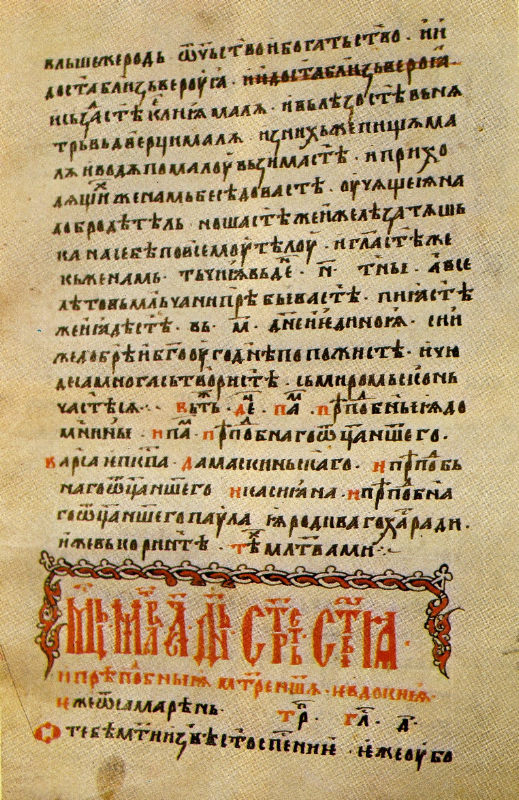
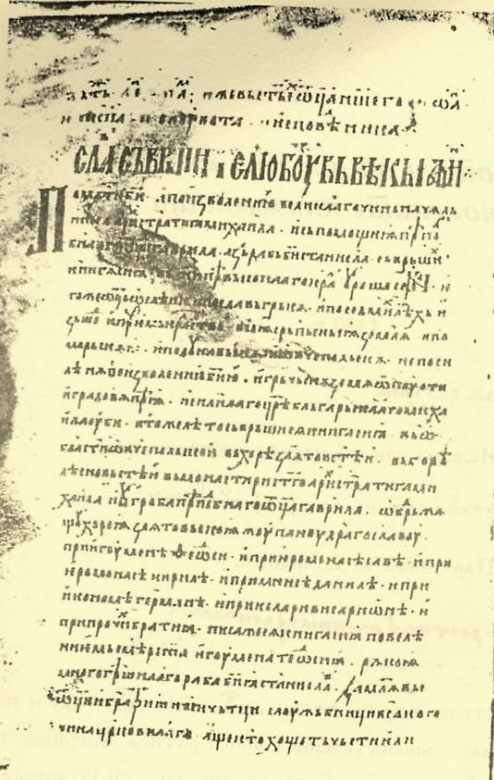
1. First Lesnovian (Stanislav’s) prolog from 1330. I + 320 ff. parchment, Cyrillic semiuncial, with juses and without juses orthography, with Macedonian language characteristics. From the last folio 321 is saved little squared piece on which is saved the writing of Stanislav from f. 320v. The manuscript was written from at least tree hands – anonymous writer. Stanislav and his student Partenij. According to the content, the manuscript represents Prolog of the whole year from the old redaction of Konstantin Mokisijski. Under 15th January stands the script of father Gavriil Lesnovski. Till 1860 it was in the monastery’s library, when some priest sold it in Belgrade to the “Serbian Slovesnian”, which in 1864 is renamed to Serbian educated brotherhood, and from 1892 is named Serbian Royal academy. Today is kept in Belgrade, SANU No.53.
Lit.: Блаже Конески, За Станиславовиот пролог, Прилози МАНУ. Одделение за лингвистика и литературна наука, II, 1-2, Скопје 1977, p. 5–23; Илија Велев, Лесновските проложни текстови и нивната редакциска застапеност, Годишен зборник на Филолошки факултет, кн.18/19, Скопје 1992/’93, p. 209–230; Илија Велев, Македонскиот книжевен XIV век, Скопје 1996, p. 45–51; Илија Велев, Лесновскиот книжевен центар, Скопје 1997, p. 131–136; Румяна Павлова, Веселка Желязкова. Станиславов (Лесновски) пролог от 1330 година. Велико Търново, 1999; Катица Трајкова, Лексиката на Станиславовиот пролог, Скопје 2002; Ѓорги Поп-Атанасов, Илија Велев и Маја Јакимовска-Тошиќ, Творци на македонската литература (IX–XVIII век), Скопје 2004, p. 96–105.
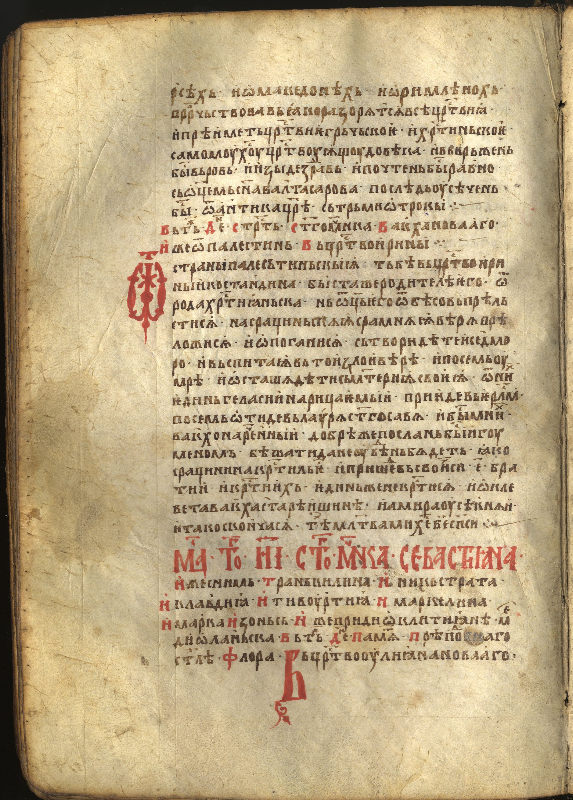
2. Second Lesnovian (Kovacevian) prolog from the time between years 1330 and 1340. 221 + 1 ff. parcement, Cyrillic semiuncial writing, with juses and without juses orthography, with Macedonian language characteristics. It’s without binding, and some folia from the beginning part are missing (first two), at the end and at the middle of the manuscript. It’s written in the Monastery of Lesnovo from two hands: anonymous writer and Stanislav Lesnovski. The prolog is of the whole year from the old version of Konstantin Mokisijski. On the 15th January stands the Vita of father Gavriil Lesnovski. Untill 1990 it was known only from the old references, when was identified as part of the manuscript’s collection of the Serbian State library in Belgrade, under sign Pc 705.
Lit.: Илија Велев, Ковачевиќев лесновски пролог, Годишен зборник на Филолошки факултет, кн.17, Скопје 1991, p. 189–208 (Истиот, Кирилометодиевската традиција и континуитет, Скопје 1997, p. 210–225); Илија Велев, Лесновските проложни текстови и нивната редакциска застапеност, Годишен зборник на Филолошки факултет, кн.18/19, Скопје 1992/’93, p. 209–230; Илија Велев, Македонскиот книжевен XIV век, Скопје 1996, p. 45–51; Румяна Павлова. Пролог Рс 705 от народната библиотека на Сърбия в Белград. Старобългаристика, 1996, № 2, p. 110-128; Илија Велев, Лесновскиот книжевен центар, Скопје 1997, p. 137–144; Илија Велев, Лесновски ковачевиќев пролог, Скопје 2004; Ѓорги Поп-Атанасов, Илија Велев и Маја Јакимовска-Тошиќ, Творци на македонската литература (IX–XVIII век), Скопје 2004, p. 96–104.
3. Third Lesnovian prolog from 1340. 155 ff., parchment, with juses and without juses orthography, with Macedonian language characteristics. It’s without beginning and folia are missing at the middle of the manuscript. It’s written in the monastery just like the previous mentioned manuscripts from the old version of Konstantin Mokisijski. It contents Vita of Gavriil Lesnovski. It was kept in State library in Belgrade, under No.27 (L.St. No.390 and ST. M. No.390). It has burned in 1941 during the bombing of Belgrade.
Lit.: В. И. Ламанский. О некоторых славянских рукописях в Белграде, Загребе и Вене. ЗИАН, 1, СПб, 1864, p. 1–147; Свњетозар Матић, Опис рукописа Народне библиотеке, Београд 1952, p. 254, оп.бр.390; Љ. Стојановић, Каталог Народне библиотеке у Београду, фот. изд., Београд 1982, p. 110–111, оп.бр.390; Илија Велев, Лесновските проложни текстови и нивната редакциска застапеност, Годишен зборник на Филолошки факултет, кн.18/19, Скопје 1992/’93, p. 209–230; Илија Велев, Македонскиот книжевен XIV век, Скопје 1996, p. 45–51; Илија Велев, Лесновскиот книжевен центар, Скопје 1997, p. 144–148; Ѓорги Поп-Атанасов, Илија Велев и Маја Јакимовска-Тошиќ, Творци на македонската литература (IX–XVIII век), Скопје 2004, p. 96–104.
4. Oliver’s Menaion from 1342. 233 ff., parchment, Cyrillic semiuncial in two columns, without juses (raška) orthography with traces of using of juses. At the end of the manuscript more than 90 folia were torn. It was written in the monastery of Lesnovo from Stanislav Lesnovski under request of the founder Joan Oliver. That’s why the manuscript is called Oliver’s. On folio 95v in script is mention the memorial service for the founder at 6th September and on folio 134v is mention the memorial service for his son Dabiz at 25th November. According to the text structure is recognized as Office menaion who contains services for September – November. In the content the days of January weren’t moved, but on the last folia, under the additional date of 15th January was the script for the service of father Gavriil Lesnovski (is considered that it was added later with the service for the local St Georgi of Kratovo from 16th century). The manuscript is saved in the Old collection in Belgrade’s State library under No.62 (L. St.191), and during its transportation of the manuscript’s collection in 1915 disappeared at the railway station in Niš (Serbia). Lit.: Љ. Стојановић, Каталог Народне библиотеке у Београду, фот. изд., Београд 1982, p. 58-59, оп.бр.191; Илија Велев, Македонскиот книжевен XIV век, Скопје 1996, p. 45-51, 151-152; Илија Велев, Лесновскиот книжевен центар, Скопје 1997, p. 148-151; Ѓорги Поп-Атанасов, Илија Велев и Маја Јакимовска-Тошиќ, Творци на македонската литература (IX-XVIII век), Скопје 2004, p. 96-104;
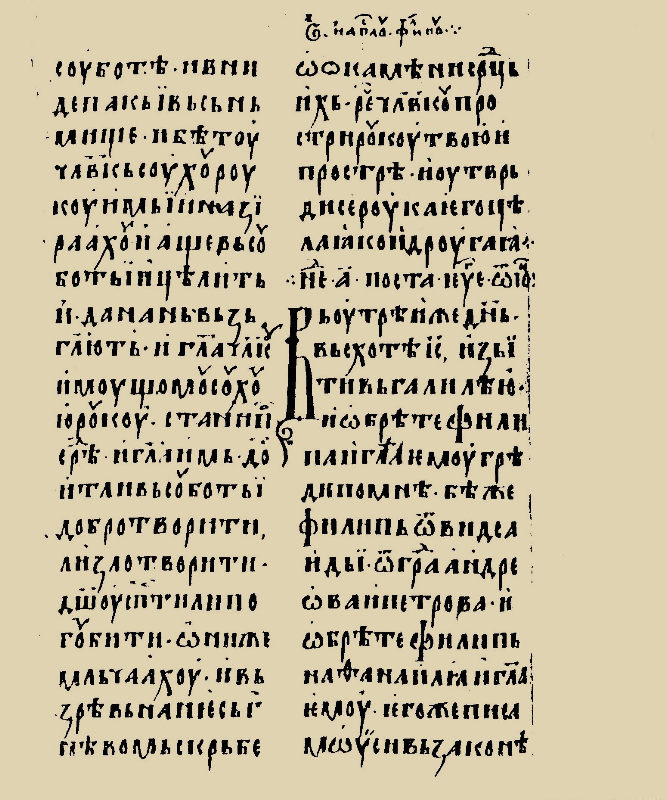
5. Lesnovian Kalinik gospel from the second quarter of 14th c. Today the manuscript is in two separately bound codexes 177 ff. + 150 ff., parchment, Cyrillic semiuncial, without juses (raška) orthography. The first folio of the second codex is missing. It was written by Kalinik in Lesnovo monastery. It’s preserved in the collection of A. Mihanovič in Zagreb (HAZU, IIIb 22 and IVd 12).
Lit.: Vladimir Mošin, Kirilski rukopisi Jugoslovenske akademije, Zagreb 1955, br.65 i 68; Л. П. Жуковская. О правомерности широких дат для пергаменных рукописей (по материале рукописей III b 22 и IV d 12 Югославянской Академии), Проблемы палеографии и кодикологии в СССР, Москва, 1974, p. 39–52; Ивона Бернс, Калиниковото лесновско евангелие, Македонски јазик, год.XXVII, Скопје 1976, p. 145–159; Илија Велев, Македонскиот книжевен XIV век, Скопје 1996, p. 51–52, 115–116; Илија Велев, Лесновскиот книжевен центар, Скопје 1997, p. 151–153; Ѓорги Поп-Атанасов, Илија Велев и Маја Јакимовска-Тошиќ, Творци на македонската литература (IX-XVIII век), Скопје 2004, p. 109–110.
6. Tetraevangelion from in the middle of 14th c. 259 ff., Cyrillic semiuncial, without juses orthography. Without beginning and end. It was written in the monastery of Lesnovo. Under the date of 15th January are mention the memorial services for St Gavriil Lesnovski and in marginal note the founder Joan Oliver and his son are mentioned. Is saved in Belgrade in the Archive of SANU under inv. No.1.
Lit.: Љ. Стојановић, Каталог Народне библиотеке у Београду, фот. изд., Београд 1982, p. 5, оп.бр.3; Илија Велев, Лесновскиот книжевен центар, Скопје 1997, p. 153–154.
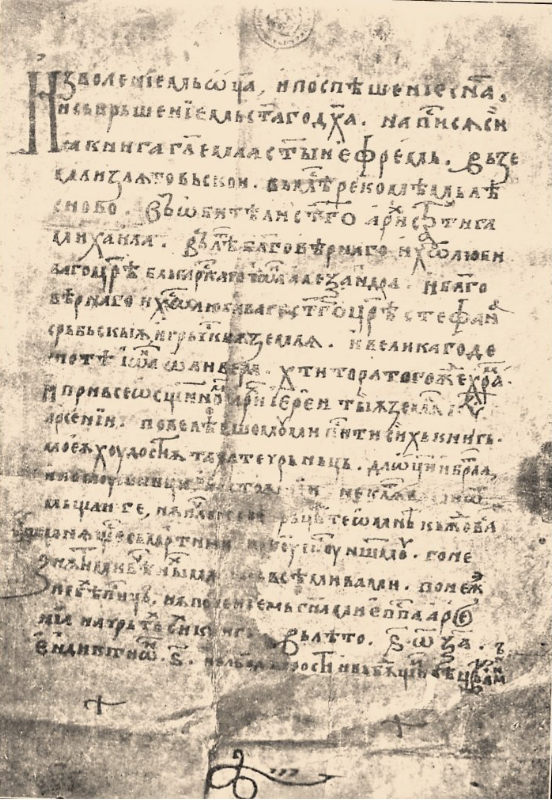
7. Lesnovian Paraenesis from 1353. 317 ff., parchment, Cyrillic semiuncial, single jus and two juses orthography of Kratovo. From 332 folia 317 are saved, most of them in the codex of 315 ff. saved in Sofia (NB, Conev I 297), and 1 folio is in the Old collection of the Belgrade’s State library (INV. No.237) and in the National library in Saint Petersburg (Fп I 63). On the folio which is in Belgrade is the colophon signed by Tahota, where is mentioned that it was written in Lesnovo after request of the Zletovian bishop Arsenij.
Lit.: Б. Цонев, Из Софийской национальной библиотеки, Сборник в честь В. И. Ламанскаго, Спб. 1906, p. 13–23; Б. Цонев, Опис на ръкописите и старопечатните книги в Народната библиотека в София, София 1910, p. 205–218; Г.Ильинский. Запись в Лесновском паренесисе Ефрема Сирина 1353 г., Списание на БАН, кн. XLV, 22, София 1933, p. 67–74; Љ. Стојановић, Каталог Народне библиотеке у Београду, фот. изд., Београд 1982, p. 188; Димитар Пандев, Лесновскиот паранесис од 1353 – лингвистичка анализа, Докторска дисертација, Архива на Филолошки факултет, Скопје 1988; Илија Велев, Лесновскиот книжевен центар, Скопје 1997, p. 154–160; Ѓорги Поп-Атанасов, Илија Велев и Маја Јакимовска-Тошиќ, Творци на македонската литература (IX-XVIII век), Скопје 2004, p. 113–116.
8. Paraenesis of Zagreb from in the middle of 14th c. 1 + 212 ff., paper, Cyrillic semiuncial, without juses reformed orthography in two columns. The last folio is missing. It was written in the Lesnovo monastery and according to its structure it shows biggest similarity to the paraenesis of Lesnovo from 1353. In the 40s of the 19th century the manuscript was bought by Austrian consul in Thessaloniki Antun Mihanovič, famous Croatian schollar. Together with the rest manuscripts from Mihanovič’s collection this one is preserved in the collection of HAZU (IIIb 12 or Mih. 14).
Lit.: Vladimir Mošin, O podrijetlu Mihanovićeve ćirilske zbirke, Slovo, 4–5, Zagreb 1955, str.76; Vladimir Mošin, Kirilski rukopisi Jugoslovenske akademije, Zagreb 1955, op.br.50; Илија Велев, Лесновскиот книжевен центар, Скопје 1997, p. 160–163.
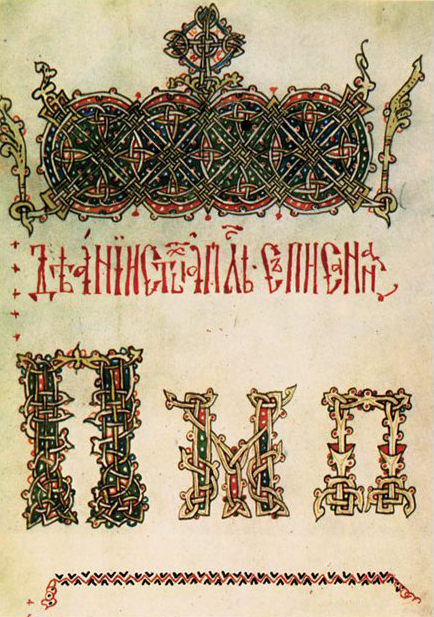
9. Drajkov’s Apostle from 1428. 256 ff., paper, Cyrillic semiuncial, with mixed jus and reformed without jus orthographic system (with ingredient of juses). It was written by literary Drakjo, who came in Lesnovo monastery from the town Bdin. According to the text structure the manuscript is apostle-aprakos. In 1519 Lesnovian abbot Dionisij sold it to Novo Selo, Štip – from whre was moved to Mihanovič’s collection, and today is saved in The Archive of HAZU in Zagreb (sign IIIb 16, Mihanovič. 19).
Lit.: Vladimir Mošin, O podrijetlu Mihanovićeve ćirilske zbirke, Slovo, 4–5, Zagreb 1955, str.77; Vladimir Mošin, Ćirilski rukopisi Jugoslovenske akademije, Zagreb 1955, op.br. 95; Илија Велев, Лесновскиот книжевен центар, Скопје 1997, p. 163-165; Ѓорги Поп-Атанасов, Илија Велев и Маја Јакимовска-Тошиќ, Скрипторски центри во средновековна Македонија, Скопје 1997, p. 164; Маја Јакимовска-Тошиќ, Македонската книжевност во XV век, Скопје 2001, p. 42 и 93–94; Ѓорги Поп-Атанасов, Илија Велев и Маја Јакимовска-Тошиќ, Творци на македонската литература (IX-XVIII век), Скопје 2004, p. 212.
10. Silvester’s Menaion from 1538 – not saved, at the beginning of 20th century disappeared from the monastery’s library and is unknown where is saved. in the literature is known through the written and published colophon of the literary Silvester from the side of Jordan Ivanov. According to the content of the colophon the literary came from Dečani in the monastery’s skit “St.Bogorodica Pizanska” on the river Zletovistica, north-east from Zletovo and there he made the transcript of the manuscript. The manuscript was taken to the library of the surrounding of the Lesnovo monastery where has already been in 1787 when on the wooden cover Smile from Rokerci was sign visiting this spiritual and literary center. In XIX century A.Gilferding has visit the Lesnovo monastery and ripped one folio from the manuscript that now is saved in the Russian national library in Saint Petersburg (sign. F. I 488).
Lit.: Йордан Иванов, Български старини из Македония, София 1931, p. 166–167; Љ. Стоjановић, Стари српски записи и натписи. Књ. IV, (фот. изд.), Beograd 1986, br. 6250, p. 47; Илија Велев, Лесновскиот книжевен центар, Скопје 1997, p. 165–166; Ѓорги Поп-Атанасов, Илија Велев и Маја Јакимовска-Тошиќ, Скрипторски центри во средновековна Македонија, Скопје 1997, p. 268–269; Ѓорги Поп-Атанасов, Илија Велев и Маја Јакимовска-Тошиќ, Творци на македонската литература (IX-XVIII век), Скопје 2004, p. 269.
11. Menaion for December from 1571 – 184 ff., paper, Cyrillic semiuncial, with without juses in two columns. It was written by priest Lazar in the monastery skit “St.Bogorodica Pizanska” at Zletovo. According to the structure is menaion with content for the holidays of the nonmoving calendar. It was transported to the library of the monastery of Lesnovo from where was taken by A.Gilferding, and today is saved in Moscow – in the State historical museum under sign Hludov No.148
Lit.: Илија Велев, Лесновскиот книжевен центар, Скопје 1997, p. 166; Ѓорги Поп-Атанасов, Илија Велев и Маја Јакимовска-Тошиќ, Скрипторски центри во средновековна Македонија, Скопје 1997, p. 123 и 269; Светлина Николова, Мария Йовчева, Таня Попова и Лора Тасева, Българското средновековно културно наследство в сбирката на Алексей Хлудов в Държавния исторически музей в Москва. Каталог, София 1999, p. 39; Ѓорги Поп-Атанасов, Илија Велев и Маја Јакимовска-Тошиќ, Творци на македонската литература (IX–XVIII век), Скопје 2004, p. 286–287.
12. Versed Prolog for June - November from 1572 – 278 ff., paper, and Cyrillic’s semiuncial, with without jus reformed orthography in two columns. It was written by priest Lazar in the monastery’s skit “St.Bogorodica Pizanska” at Zletovo. The manuscript is versed prolog with translation from the Byzantine original, which doesn’t have changes of the Slovenian saints. There are more marginal notes through the manuscript from later time that were written by visitors and members of the Lesnovo’s monastery. Probably this manuscript was sold to the Austrian consul in Thessalonica A.Mihanovic in the 40s of XIX century and today is saved in Mihanovic’s collection in HAZU in Zagreb (sign IIIc 14, Mihanovik 13).
Lit.: Vladimir Mošin, O podrijetlu Mihanovićeve ćirilske zbirke, Slovo, 4–5, Zagreb 1955, str.76; Vladimir Mošin, Ćirilski rukopisi Jugoslovenske akademije, Zagreb 1955, op.br. 116, p. 184–185; Илија Велев, Лесновскиот книжевен центар, Скопје 1997, p. 166–167; Ѓорги Поп-Атанасов, Илија Велев и Маја Јакимовска-Тошиќ, Скрипторски центри во средновековна Македонија, Скопје 1997, p. 269–271; Ѓорги Поп-Атанасов, Илија Велев и Маја Јакимовска-Тошиќ, Творци на македонската литература (IX-XVIII век), Скопје 2004, p. 286–287.
13. Lesnovian requiem from 16 and 18th – 19th c. 110 ff., paper, from which 8 folia from the old requiem from 16 century, and the rest 102 folia from 18th century (at the empty folia is adding from 19th century). The first part of 16 century is very interesting and has dates with memorial services of the tsars, founders, archiepiscopal and many more. Through the folia of the Requiem are transcript important scripts for the Lesnovo monastery. The manuscript is not saved, but it was in the Old collection of the Belgrade’s State library (inv. No.235, L. St. 533). It was burned during the bombing of Belgrade in 1941.
Lit.: Стојан Новаковић, Српски поменици XV–XVIII века, Гласник српског ученог друштва, књ.XLII, Београд 1875, p. 28–35; Љ. Стојановић, Каталог Народне библиотеке у Београду, фот. изд., Београд 1982, p. 387, оп.бр. 533; Радмила Угринова-Скаловска, За македонските кодици, Предавања на XIII Семинар за македонски јазик, литература и култура, Скопје 1980, p. 31–34; Илија Велев, Лесновскиот книжевен центар, Скопје 1997, p. 167–168; Ѓорги Поп-Атанасов, Илија Велев и Маја Јакимовска-Тошиќ, Скрипторски центри во средновековна Македонија, Скопје 1997, p. 166.
14. Zagreb’s Oktoechos from 1685 – VI + 220 ff., paper, Cyrillic semiuncial from later time, without juses with Macedonian language characteristics on f. 213v. It’s assumed that it was written by tree hands in the Lesnovian scriptorium or in his surrounding. According its content is weekly oktoih. The Sunday’s gospels are not split at the end of the texts (as it’s in the manuscripts from the Trnovian literary school), but they are written at the beginning. During 17th century the manuscript was taken to the Slavonian area from where was taken to the Zagreb’s archeology museum. Its principal Josip Brunsmid has given it to the City library (sign P 64).
Lit.: Marko Orešković, Rijedak ćirilski rukopis u gradskoj knjižnici u Zagrebu, Библиотекар, бр.5–6, Београд 1965, p. 428–431; Мара Харисијадис, Минијатуре и орнаменти Октоиха Р. 64 Градске библиотеке у Загребу, Зборник за ликовне уметности, бр.4, Нови Сад 1968, p. 283–296; Илија Велев, Лесновскиот книжевен центар, Скопје 1997, p. 169–173; Ѓорги Поп-Атанасов, Илија Велев и Маја Јакимовска-Тошиќ, Скрипторски центри во средновековна Македонија, Скопје 1997, p. 168.
15. Acatist from 1811 – not preserved and is not identified. According to the published colophon of the same manuscript is it was written by priest Niko(la) in the monastery of Lesnovo where after the Balkans wars in 1912/’13 was taken to unknown direction.
Lit.: Стеван Симић, Лесновски манастир Св. оца Гаврила, Београд 1913, p. 80; Йордан Иванов, Български старини изъ Македония, София 1931, p. 167; Илија Велев, Лесновскиот книжевен центар, Скопје 1997, p. 173–174; Ѓорги Поп-Атанасов, Илија Велев и Маја Јакимовска-Тошиќ, Скрипторски центри во средновековна Македонија, Скопје 1997, p. 169.
16. Collection of Services and Vitas of St Gavriil Lesnovski from 1868. I + 42 ff., paper, Cyrillic writing on Church Slavonic language. It was written by priest Joan Hrstev from Kratovo, who in that time was only 13 years old and was preparing colors for the manuscript by himself (on f. 4v is painted portrait of St.Gavriil Lesnovski). Today the manuscript is saved in Sofia, NB No.988.
Lit.: Йордан Иванов, Северна Македония, София 1906, p. 97; Илија Велев, Лесновскиот книжевен центар, Скопје 1997, p. 118–119 и 176–178; Илија Велев, Св. Гаврил Лесновски во книжевната традиција, Скопје 1996, p. 79–103.
17. Miscellany of Dimitrie Hristov from 1886 – 92 ff., paper, Cyrillic writing on Church Slavonic language. It was written by teacher Dimitrie Hristov Kratovian and in it are the service and the vita for Gavriil Lesnovski, the colophon about the Lesnovo monastery such as tropfars for Joan Rilski and Joakim Osogovski. Now it is kept in Sofia, CIAI No. 1188, where was brought during the Second world war when the Bulgarian military was on the territory of Macedonia from Bulgarian military people during The First World War.
Lit.: Илија Велев, Лесновскиот книжевен центар, Скопје 1997, p. 118 и 178–179; Илија Велев, Св. Гаврил Лесновски во книжевната традиција, Скопје 1996, p. 79–103.
18. Lesnovian memorial from XIX century and the beginning of XX century – 201 ff., paper, Cyrillic writing on Macedonian common language, with marginal notes in Bulgarian language from Bulgarian military people during the First World War. At the beginning the manuscript had 209 folia and 8 from them were torn after a while. Probably part from this manuscript are the two ripped folia with the List of inventory and the incomes and outcomes of the monastery which are saved in Skopje, NUB “St.Kliment Ohridski” (sign M-33v). The manuscript is tight with wood in skin and is saved in the manuscript’s collection in the Philological Faculty “Blaze Koneski” in Skopje (sign PC 18).
b) Manuscripts that come from the library of the Lesnovo monastery
1.Readings from Gospel and Apostle from the middle of the 13th c. Fragment 2 ff., parchment, Cyrillic semiuncial, without juses (early raška) orthography system. There is possibility that together with another 2 paged fragment are parts of together codex (Belgrade, NB, New Collection Pc 1). Now part of the Lesnovian collection of the University Library in Belgrade, Čorovič frm.2.
2.Bogdan’s Tetraevangelion from the end of 12th and the beginning of 14th c. 259 ff., parchment, Cyrillic writing with liturgical constitution in two columns, without juses. It was written by the literary Bogdan who comes from Štip, but at one time was staying in the library of the Lesnovo monastery. Saved in Zagreb, Archive of HAZU, IIIc 20 (Mih. 24).
3.Script of St. Sava from Domenijan from the time around 1340. Fragment 1 ff., paper, Cyrillic semi constitution writing, without juses. Now part of the Lesnovian collection of the University Library in Belgrade, Čorovič fgm.6.
4.Miscellany for Virgin Mary (Bogorodičnik) with Praise for Saint Simeon and Sava from Teodosij from the time around 1340–1360. 217 ff., paper, and Cyrillic semi constitution writing, without juses orthography. Written by the literary Pafnutij and other anonymous writers. Now part of the Lesnovian collection of the University Library in Belgrade, Čorovič 19.
5.Menaion for December-February from 14th c. 313 ff., parchment, Cyrillic semiuncial with juses orthography (Kratovo’s). It was written by the literary Stanislav (probably Stanislav Lesnovski in the Lesnovo monastery), and later on the manuscript are added the services for St.Gavriil Lesnovski and St.Gorgi Kratovian (ff.20v-20r and ff.257v). It was in the temple “St John the Forerunner” from where was taken to the Old collection of the Belgrade’s State library, inv. No.15, L.St.209.
Lit.: Љуб. Стојановић, Каталог Народне библиотеке у Београду, фот. изд., Београд 1982, p. 62–63, оп.бр. 209; Илија Велев, Лесновскиот книжевен центар, Скопје 1997, p. 100–101; Ѓорги Поп-Атанасов, Илија Велев и Маја Јакимовска-Тошиќ, Скрипторски центри во средновековна Македонија, Скопје 1997, p. 159; Ѓорги Поп-Атанасов, Илија Велев и Маја Јакимовска-Тошиќ, Творци на македонската литература (IX–XVIII век), Скопје 2004, p. 103–104.
6.Menaion for June from the second quarter of 14th c. 1 + 123 ff., parchment and paper, Cyrillic semiuncial, without juses orthography. Written by tree hands. Now part of the Lesnovian collection of the University Library in Belgrade, Čorovič 15.
7.Menaion for August from the secong quarter of 14th c. and part of 16th c. 122 ff., parchment and paper, Cyrillic writing with just kratovian and without juses. Written by more hands, with script of Novak. Now part of the Lesnovian collection of the University Library in Belgrade, Čorovič 17.
8.Office from the middle of 14th c. 143 ff., parchment, Cyrillic semiuncial, without juses. It was written by the literary Atanasij, and illuminated by Neofit. Now part of the Lesnovian collection of the University Library in Belgrade, Čorovič 7.
9.Apostle from the third quarter of 14th century – fragment 1 ff., paper, Cyrillic semiuncial, without juses. Now part of the Lesnovian collection of the University Library in Belgrade, Čorovič fragment 9.
10.Ladder of Paradise from the time around 1370 – 263 + 1 ff., paper, Cyrillic semiuncial, without juses. Now part of the Lesnovian collection of the University Library in Belgrade, Čorovič 25.
11.Miscellany from the time between 1380/’95 and the end of XV and beginning of 16 century – 221 ff., paper, Cyrillic writing with jus and without juses. Now part of the Lesnovian collection of the University Library in Belgrade, Čorovič 27.
12.Gracanian Prolog – Menaion for September – November from the last quarter of 14th century – 420 ff., paper, Cyrillic semiuncial in two columns, without juses. It was in the Lesnovo monastery and together with another separated manuscript that was saved in the library of the Pcinja’s monastery (Zagreb, HAZU IIIc 22) are representing codex together. It was written from the literary Drago and other anonymous writers. Saved in Zagreb, HAZU, IIIc 24 (Mihanovik 23).
13.Miscellany with Homilies of Abba Doroteos from the last quarter of XIX century – 133 ff., paper, Cyrillic semiuncial, without juses. Now part of the Lesnovian collection of the University Library in Belgrade, Čorovič 24.
14.Lesnovian Miscellany from the time between 1390 and 1400 – 322 ff., paper, Cyrillic semiuncial, without juses, without beginning and end. According to the attribution of the writing is assumed that it was written by the famous literary Jov. Now part of the Lesnovian collection of the University Library in Belgrade, Čorovič 28.
15.Lesnovian anthological Miscellany from the end of 14th century – 261 ff., paper, Cyrillic semiuncial, without juses. Now part of the Lesnovian collection of the University Library in Belgrade, Čorovič 29.
16.Lesnovian Miscellany from the end of 14th century – 342 ff., paper, Cyrillic semiuncial, without juses. Now part of the Lesnovian collection of the University Library in Belgrade, Čorovič 30.
17.Infertile triode from the end of 14th and beginning of XV century – fragment from 17 folia, paper, Cyrillic semiuncial, without juses. Saved in Moscow, State library, Popov f.236/103, M-2578.
18.Lent Triodion from the time between 14th and XV century – fragment from 8 folia, parchment, Cyrillic semiuncial, without juses. Saved in Sent Petersburg, National library, Vjazemski F. 124/5.
19.Flowery Triodion from the first quarter of XV century – 240 ff., paper, Cyrillic semiuncial, without juses. Now part of the Lesnovian collection of the University Library in Belgrade, Čorovič 22.
20.Oktoechos on 5 Modes from 1434 – 214 ff., paper, Cyrillic semiuncial, without juses. Now part of the Lesnovian collection of the University Library in Belgrade, Čorovič 20.
21.Menaion for October from the first third of XV century – 117 ff., paper, Cyrillic semiuncial, without juses. Now part of the Lesnovian collection of the University Library in Belgrade, Čorovič 18.
22.Office Menaion from XV century – fragment from 1 ff., Cyrillic semiuncial, without juses. Now part of the Lesnovian collection of the University Library in Belgrade, Čorovič fragment 12.
23.Menaion for March – April from XV century – 1 + 219 + 1ff., paper, Cyrillic semiuncial, without juses. Written by Filimon. Saved in Sofia, NB No. 899.
24.Karpinian Lent Triodion from XV century – 216 ff., paper, Cyrillic semiuncial, without juses. Is coming from Karpinian monastery and in 17 century was added to the Lesnovo monastery. Saved in Sofia, NB No. 581.
25.Tetraevangelion from XV century – 211 ff., paper, Cyrillic semiuncial, without juses with ingredient of jus orthography. Saved in Plovdiv, NB, Conev 16.
26.Menologion from the second half of XV century with additional from 17 century – 179 ff., paper, Cyrillic semiuncial, without juses – without beginning and end. In the script is mentioned the Lesnovo monastery and the monasticism of priest Gore. Saved in Sofia, NB No. 982.
27.Flowery Triodion from the third quarter of XV century – 218 ff., paper, Cyrillic semiuncial, jus and without juses. One of the writers of the manuscript was literary Radota. Now part of the Lesnovian collection of the University Library in Belgrade, Čorovič 23.
28.Lesnovian Tetraevangelion from the third quarter of XV century – 242 ff., paper, Cyrillic semiuncial, without juses. Now part of the Lesnovian collection of the University Library in Belgrade, Čorovič 2.
29.Aprakos Gospel from the time between 1480 – 1490 and from 1520 – 242 ff., paper, Cyrillic semiuncial, without juses. Now part of the Lesnovian collection of the University Library in Belgrade, Čorovič 4.
30.Miscellany from XV – 16 century – 197 ff., paper, Cyrillic semiuncial, without juses – without beginning and end. Its three different manuscripts in together codex, with texts, church-services and general content. Saved in the Old collection in the Belgrade’s State library, inv. No.1.229, St. Matik 200.
31.Apostle from the time around 1500 – 222 ff., paper, Cyrillic semiuncial, without juses. Written by three hands. Now part of the Lesnovian collection of the University Library in Belgrade, Čorovič 5.
32.Apostle from the beginning of 16 century, 148 ff., paper, Cyrillic semiuncial, without juses. Now part of the Lesnovian collection of the University Library in Belgrade, Čorovič 6.
33.Menaion for March – May from the time between 1510 and 1520 – 114 ff., paper, Cyrillic semiuncial, without juses. In the notes through the literary is mentioned it is kept in the Lesnovian collection of the University Library in Belgrade, Čorovič 14, but now the manuscript is not in the mentioned collection. Long-time researcher for new description of these manuscripts Biljana Stipcevik thinks that with the manuscript Čorovič 26 (Nomocanon from 1552) weren’t brought in the University library from the Serbian seminar by Philosophical Faculty in Belgrade.
34.Psalter from the time between 1510 and 1520 – 187 ff., paper, Cyrillic semiuncial, without juses. Written by monk Filimon, probably in the church “St.Nikola” in Vojneg and after that the manuscript was transported in the Lesnovo monastery. Now part of the Lesnovian collection of the University Library in Belgrade, Čorovič 9.
35.Psalter from the same time between 1510 and 1520 - 341 ff., paper, Cyrillic semiuncial, without juses. Now part of the Lesnovian collection of the University Library in Belgrade, Čorovič 10.
36.Psalter from 1515 – 251 ff., paper, Cyrillic semiuncial, without juses. It was written by monk Filimon in the church “St.Nikola” in the place Vojneg, Probishtip – there is a bigger script that testifies about that. During 18 century was in the library of the Lesnovo monastery. Now part of the Lesnovian collection of the University Library in Belgrade, Čorovič 11.
37.Menaion for December from the first half of 16 century – fragment 2 ff., paper, Cyrillic semiuncial, without juses. Now part of the Lesnovian collection of the University Library in Belgrade, Čorovič fgm.1.
38.Menaion for July and August from the second quarter of 16 century – 305 ff., paper, Cyrillic semiuncial, without juses. Now part of the Lesnovian collection of the University Library in Belgrade, Čorovič 16.
39.Lent Triodion from the second quarter of 16 century – 340 ff., paper, Cyrillic semiuncial, without juses. Now part of the Lesnovian collection of the University Library in Belgrade, Čorovič 21.
40.Tetraevangelion from the time around 1550 – 187 ff., paper, Cyrillic semiuncial, jus orthography with Macedonian language characteristics. Now part of the Lesnovian collection of the University Library in Belgrade, Čorovič 1.
41.Menaion for February from the time between 1550 and 1560 – 160 ff., paper + 2 folia parchment. Cyrillic semiuncial, without juses. Now part of the Lesnovian collection of the University Library in Belgrade, Čorovič 12.
42.Lesnovian Bible from the middle of XV century – 336 ff., paper, Cyrillic semiuncial, without juses. Saved in Zagreb, HAZU, IIIc 17 (Mihanovik 28) – Moshin 61.
43.Dogmatic Panoply from the middle of 16 century – 373 ff., paper, without the first folio from the beginning and 9 folia of the end. Cyrillic semiuncial, without juses. Saved in Zagreb, HAZU, IIIc 17 (Mihanovik 18) – Moshin 56.
44.Psalter from the middle of 16 century – 378 ff., paper, Cyrillic semiuncial, without juses. Written by two hands. Saved in Skopje, NUB “St. Kliment Ohridski”, M-19, Moshin 55.
45.Prophecy book from the middle of 16 century – 428 ff., paper, without and end. Cyrillic big semiuncial, without juses. Written by the literary Matej in Slepcenski’s monastery at Demir Hisar. In 17 century the manuscript was in the library of the Lesnovo’s monastery. Saved in Moscow, DIM, Hludov 1.
46.Canonic from the third quarter of 16 century – 198 ff., Cyrillic semiuncial, without juses. Now part of the Lesnovian collection of the University Library in Belgrade, Čorovič 8.
47.Tetraevangelion from the third quarter of 16 century – 185 ff., Cyrillic semiuncial, without juses. Now part of the Lesnovian collection of the University Library in Belgrade, Čorovič 3.
48.Gospel by Matej (Lesnovian) from the second half of 16 century – I +82 ff., paper, part of Tetraevangelion, Cyrillic semiuncial, without juses. Zagreb, HAZU, IIIc 11 (Mihanovik 12) – Moshin 82.
49.Lesnovian Tetraevangelion from the second half of 16 century – 307 ff., Cyrillic semiuncial, without juses. Zagreb, HAZU, IIIb 8 (Mihanovik 1) – Moshin 81.
50.Gospel by Matej from the last quarter of 16 century – fragment 1 ff., paper, Cyrillic semiuncial, without juses. Now part of the Lesnovian collection of the University Library in Belgrade, Čorovič fgm.5.
51.Office Menaion for March from the end of 16 century – fragment 4 ff., paper, Cyrillic semiuncial, without juses. Now part of the Lesnovian collection of the University Library in Belgrade, Čorovič fgm.7.
52.Gospel by Joan from the first half of 17 century – fragment from Tetraeangelion 2 ff., paper, Cyrillic semiuncial, without juses. Now part of the Lesnovian collection of the University Library in Belgrade, Čorovič fgm.4.
53.Lent triodion from the second quarter of 17 century – fragment 1 ff., paper, Cyrillic semiuncial, without jus. Now part of the Lesnovian collection of the University Library in Belgrade, Čorovič fgm.3.
54.Canonic from the middle of 17 century – fragment 2 ff., paper, Cyrillic semiuncial, without juses. Now part of the Lesnovian collection of the University Library in Belgrade, Čorovič fgm.10.
55.Oktoechos from 17 c. 140 ff., paper, Cyrillic semiuncial, without juses. Saved in the Old collection by Belgrade’s State library, inv. No.394, L. St. 254.
Selected References
- Велев И. Лесновски Ковачевиќев пролог, Скопје, 2004
- Велев И. Свети Гаврил Лесновски во книжевната традиција. Скопје,1996;
- Велев И. Лесновскиот книжевен центар. Скопје, 1997;
- Велев И. Лесновските проложни текстови и нивната редакциска застапеност. Годишен зборник на Филолошки факултет, кн.18/19, Скопје 1992/93, 209-230
- Велев И. Записи и натписи од Лесновскиот книжевен центар, Скопје 2001;
- Габелиħ С. Манастир Лесново. Историја и сликарство, Београд, 1999
- Георгиевски М. Македонското книжевно наследство од XI до XVIII век, Скопје, 1979
- Иванов Й. Български старини из Македония. София, 1931
- Конески Б. За Станиславовиот пролог, Прилози МАНУ, II, 1-2, Скопје, 1977, 5-23
- Ламанский В. О некоторыхъ славянскихъ рукописяхъ въ Белграде, Загребе и Вене. Записки имп. академи наукъ. 1, СПб, 1864
- Пандев Д. Лесновскиот паранесис од 1353 – лингвистичка анализа. Докторска дисертација, Филолошки факултет, Скопје 1988
- Павлова Р., В. Желязкова. Станиславов (Лесновски) пролог от 1330 година. Велико Търново 1999
- Поп-Атанасов Ѓ., И. Велев и М. Јакимовска-Тошиќ, Скрипторски центри во средновековна Македонија, Скопје 1997;
- Поп-Атанасов Ѓ., И. Велев и М. Јакимовска-Тошиќ, Творци на македонската литература (IX-XVIII век), Скопје, 2004;
- Симиħ Ст. Лесновски манастир Св. оца Гаврила, Београд 1913;
- Стојановиħ Љуб. Каталог Народне библиотеке, Фот. изд., Београд, 1982;
- Стојановиħ Љуб. Каталог рукописа и старих штампаних књига збирка Српске краљевске академије, Београд 1901
- Трајкова К. Лексиката на Станиславовиот пролог. Скопје, 2002;
- Цонев Б. Опис на ръкописите и старопечатните книги в Народната библиотека в София. София, 1910.
- Ћоровиħ В. Рукописи Лесновског манастира, Зборник за историју Јужне Србије, Скопље 1936;
- Mošin V. Ćirilski rukopisi Jugoslovenske akademije. Zagreb, 1955
- Mošin V. O podrijetlu Mihanovićeve ćirilske zbirke, Slovo, 4-5, Zagreb, 1955